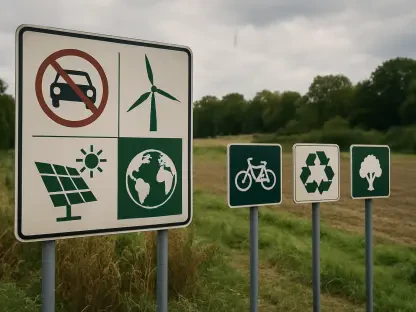Dive into the world of sustainable packaging with Christopher Hailstone, a seasoned expert in energy management and renewable energy, who brings a unique perspective to the circular economy and plastic packaging challenges. As our Utilities expert, Christopher offers deep insights into systemic issues and innovative solutions that shape industries. In this interview, we explore the progress and hurdles of the Ellen MacArthur Foundation’s Global Commitment, the disparity in industry adoption, standout achievements by companies like SC Johnson, and the ambitious path forward to 2030. Join us as we unpack how businesses are navigating the complex landscape of plastic waste reduction and recycling.
Can you walk us through the core mission of the Ellen MacArthur Foundation’s Global Commitment and what it set out to achieve by 2025?
Absolutely. The Global Commitment, launched in 2018, is a bold initiative to transform how plastic packaging is managed across the value chain. Its main mission is to create a circular economy for plastics by making packaging recyclable, compostable, or reusable by 2025. Beyond that, it aimed to eliminate unnecessary or problematic plastics, boost the use of post-consumer recycled content, and increase reusable packaging options. The idea was to unite businesses, from producers to retailers, in a shared effort to rethink plastic use and minimize waste on a global scale.
What do you see as the biggest obstacles companies faced in hitting those 2025 targets, based on the latest progress report?
The report highlights a mix of progress and shortfalls, and I think the challenges stem from both internal and external factors. Internally, many companies struggled with the high costs and technical barriers of shifting to recycled materials or redesigning packaging for circularity. Areas like reducing virgin plastic use or scaling up recycling infrastructure saw slower progress than hoped. Externally, systemic issues like inconsistent regulations, limited access to quality recycled materials, and fragmented global markets played a huge role. It’s often not just about a company’s willpower but the broader ecosystem they operate in.
With only 20% of the plastic packaging market joining the Global Commitment, why do you think the other 80%, including major players, stayed on the sidelines?
That’s a critical gap. I believe many companies, especially larger ones, hesitated due to the perceived risks of transparency and accountability that come with signing on. Publicly reporting progress means facing scrutiny, and not all are ready for that. There’s also the issue of short-term costs versus long-term gains—some prioritize immediate profits over investing in sustainability. Plus, without mandatory regulations in many regions, there’s little external pressure to join. It’s often easier to fly under the radar than commit to ambitious targets.
How can the industry bring that remaining 80% into the fold for the next phase by 2030?
It’s going to take a multi-pronged approach. First, showcasing tangible benefits—like cost savings from recycled materials or brand loyalty from eco-conscious consumers—can incentivize participation. Second, stronger collaboration between governments and industry to create consistent policies and infrastructure for recycling could lower barriers. Finally, public awareness campaigns and consumer pressure can push companies to act. If customers demand sustainable practices, that 80% will feel the heat to join initiatives like the Global Commitment.
The report notes that signatory brands and retailers tripled their recycled content use from 4.6% in 2018 to 15.9% in 2024. What do you think fueled this impressive leap compared to the global market’s sluggish growth?
That jump is remarkable and shows what focused commitment can achieve. Signatories likely benefited from setting clear goals and being held accountable through transparent reporting. Many invested in partnerships with recyclers and innovated with new materials or designs to incorporate more recycled content. Access to shared knowledge within the Global Commitment network probably helped too. Meanwhile, the global market, with only a rise from 3.4% to 4.2%, lacks that unified drive and often faces supply chain constraints for quality recycled materials, slowing progress.
SC Johnson cut virgin plastic use by 33% since 2018 while getting recycled content into a quarter of their packaging. What lessons can other consumer goods companies take from their strategy?
SC Johnson’s success is a standout case. They’ve shown that aggressive targets paired with actionable steps—like redesigning products and sourcing recycled materials—can yield big results. Their willingness to innovate and invest upfront in sustainable packaging sets a benchmark. Other companies can learn to prioritize long-term vision over short-term costs and build strong supplier relationships to secure recycled content. It’s also about internal alignment—getting every department on board with sustainability goals makes execution smoother.
SC Johnson has been vocal about supporting federal extended producer responsibility laws. How do you think this kind of policy could reshape the industry’s approach to plastic waste?
Extended producer responsibility, or EPR, could be transformative. It shifts the burden of waste management back to producers, making them financially and operationally accountable for recycling and collection systems. For an industry often reliant on voluntary action, EPR laws would create a level playing field, pushing even reluctant companies to innovate. It could drive funding for better infrastructure and incentivize designs that are easier to recycle. If done right, it’s a policy that could accelerate the circular economy across the board.
Looking at the updated Global Commitment for 2030, with 20% of the market already signed on, what sets this next chapter apart from the first phase?
The 2030 phase builds on lessons from the past seven years with sharper, more ambitious targets. It’s not just about continuing the work but scaling it in a tougher context—think economic pressures and regulatory complexities. There’s a stronger emphasis on systemic change, like pushing for global policy alignment and engaging a broader range of stakeholders, from recyclers to plastic producers. The focus on public reporting remains, but there’s a clearer call to address the 80% of the market that’s lagging. It’s a more mature, urgent push for transformation.
What’s your forecast for the future of plastic packaging circularity as we head toward 2030?
I’m cautiously optimistic. We’ve seen what committed companies can achieve, like tripling recycled content or slashing virgin plastic use. But the pace needs to accelerate, especially for that 80% of the market still on the sidelines. I expect stricter regulations and consumer demand will force more players to act, while innovations in materials and recycling tech could ease some barriers. By 2030, we might see a tipping point where circular practices become the norm, not the exception—but only if collaboration across industries and governments ramps up significantly.









